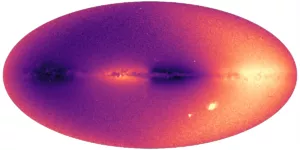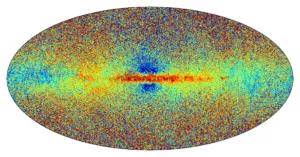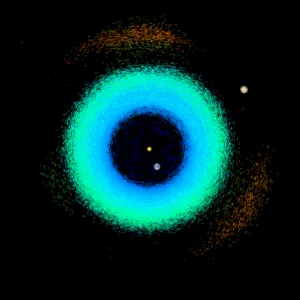On June 13, 2022, the European Space Agency's Gaia Mission completed the most detailed ever maps of the Milky Way, with data on nearly two billion stars. With Gaia's third data release, astronomers, including Hungarian researchers, have made some impressive discoveries, ranging from strange star vibrations, to the 'DNA' of the stars, stars in the process of being born and asteroids located within our Solar System. Gábor Marton, a research fellow at the Astronomical Institute of the ELKH Research Centre for Astronomy and Earth Sciences, was responsible for leading the identification of young stars. A more detailed analysis of the luminosity changes now observed by the Gaia space telescope could provide new insights into, among other things, the formation of comets, planets, and distant solar systems, ongoing chemical transformation processes, and the evolution of planetary orbits.
ESA Gaia's mission is to create the most accurate and complete multidimensional map of the Milky Way in existence, thereby enabling astronomers to reconstruct the structure and evolution of our galaxy over the past billions of years and to gain a better understanding of the life cycle and location of stars in the universe.

What's new in the third data release?
Gaia Data Release 3 contains new and more precise than ever information about nearly two billion stars in our galaxy. The catalog includes new data such as chemical composition, temperature, color, mass and age of stars, as well as their radial speed, i.e. their speed as they are approaching or moving away from us. Much of this information has been identified from newly published spectroscopic data, a technique in which the starlight is split into its constituent colours, similar to a rainbow. The data also includes special subsets of stars, like those that change brightness over time.
Starquakes
One of the most surprising discoveries related to Gaia’s new data is that the observatory, although not originally designed for this purpose, is still able to detect starquakes – tiny motions on the surface of a star – that change the shapes of stars. Previously, Gaia already found radial oscillations that cause stars to swell and shrink periodically, while keeping their spherical shape, but Gaia has now also spotted other vibrations that are more like large-scale tsunamis. These non-radial vibrations slightly change the shape of the star, making them harder to detect.
“Starquakes teach us a lot about stars, notably their internal workings. Gaia is opening a goldmine for ‘asteroseismology' of massive stars,” said Conny Aerts, a member of the Gaia Scientific Collaboration and a professor at the Catholic University of Leuven in Belgium, who recently received the Kavli Prize for her pioneering work on the subject.
The DNA of stars
The composition of the stars can tell a lot about their place of birth and their subsequent journey, including the history of the Milky Way. With this release, Gaia reveals the largest chemical map of the galaxy to date, from the vicinity of our Sun to the smaller galaxies around us, linking it to the three-dimensional motion of the stars.

Some stars contain more 'matter' than others. During the Big Bang, only light elements (hydrogen and helium) were formed. All the other heavier elements – which astronomers uniformly refer to as metals – were formed inside the stars and could only be transferred to new stars after their destruction. In other words, the chemical composition of the stars is like their DNA, and may contain key information about their origins. Gaia has also helped show us that stars that are closer to the centre and plane of our galaxy are richer in metals than stars at larger distances. Gaia also identified stars that originally came from different galaxies than our own, based on their chemical composition.
"Our galaxy is a beautiful melting pot of stars. This diversity is extremely important, because it tells us the story of our galaxy’s formation. It reveals the processes of migration within our galaxy and accretion from external galaxies. It also clearly shows that our Sun, and we, all belong to an ever changing system, formed thanks to the assembly of stars and gas of different origins.” Says Alejandra Recio-Blanco of the Observatoire de la Côte d’Azur in France, who is a member of the Gaia collaboration.
Asteroids, quasars and stars in the process of being born
The additional articles just published reflect the depth and breadth of the discovery of the Gaia Space Telescope. The new binary star catalog shows the mass and evolution of more than 800,000 binary star systems, while a new asteroid survey of 156,000 small celestial bodies will help contribute to the discovery of the origin of our solar system. Gaia is also revealing information about 10 million variable stars, mysterious macro-molecules between stars, as well as quasars and galaxies beyond our own cosmic neighbourhood.
The search for and identification of variable stars is a particularly important area for Hungarian researchers working in the Gaia Scientific Consortium, including Gábor Marton (CSFK). Gaia observes young stars in a state where there is already a planet-forming plane around them, and the germination of planets has already appeared on this plane. “In addition to obscuring the light of their parent star, which Gaia also senses, these very young planets can interact in other ways, which also causes changes in the brightness of systems that can also be detected by space telescopes. Gaia 'looks' at these light sources at regular intervals for a long period time, so it is also excellent for observing rare but drastic events," summarizes Gábor Marton.
A more detailed analysis of luminosity changes can reveal how different distant solar systems form around stars, how planetary orbits evolve, and how interstellar dust particles are chemically transformed into complex materials that make up comets, asteroids and planets.
“Unlike other missions that target specific objects, Gaia is a survey mission. This means that while surveying the entire sky with billions of stars multiple times, Gaia is bound to make discoveries that other more dedicated missions would miss. This is one of its strengths, and we can’t wait for the astronomy community to dive into our new data to find out even more about our galaxy and its surroundings than we could’ve imagined,” concluded Timo Prusti, senior researcher at ESA’s Gaia mission.
